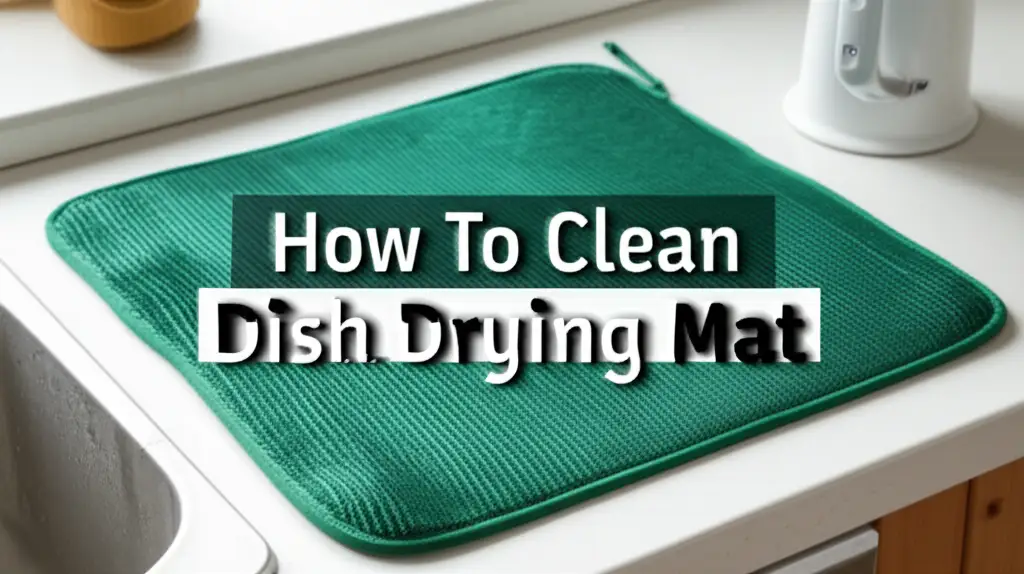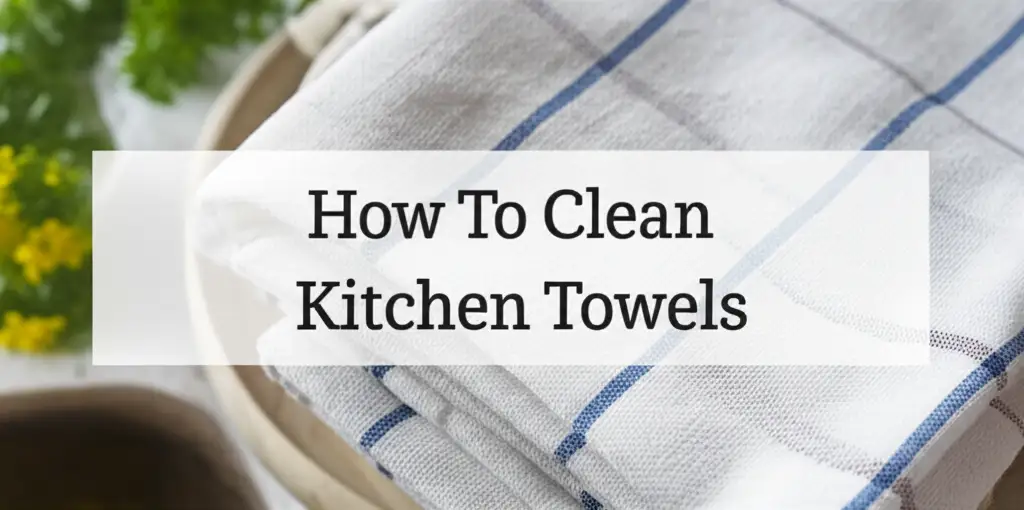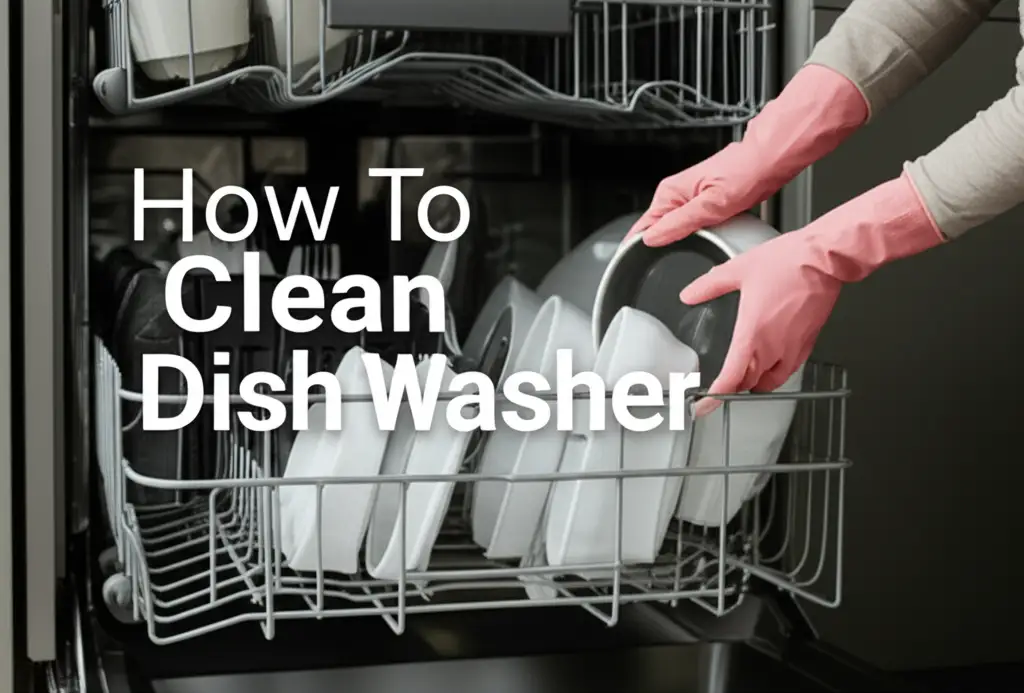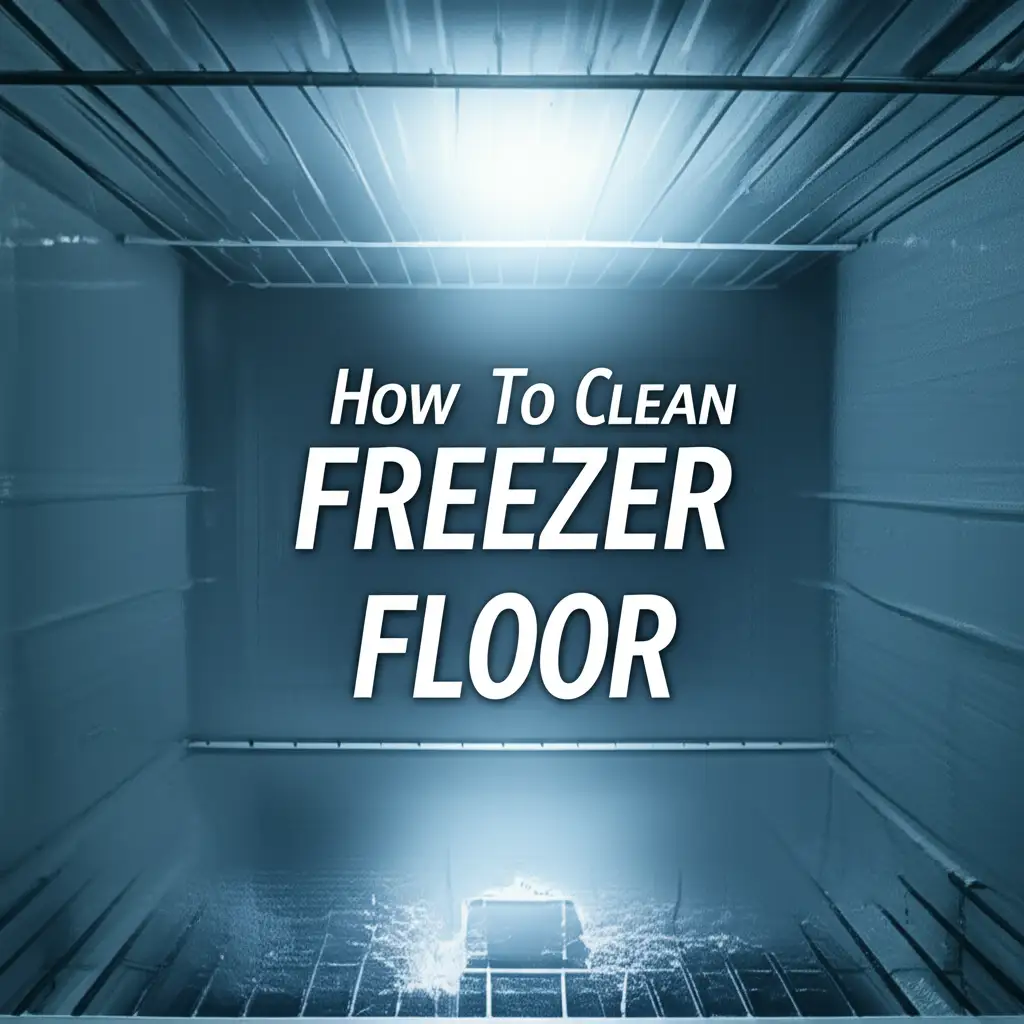· Home Cleaning · 19 min read
How To Clean Dish Drying Mat

Sparkling Clean: How to Clean Your Dish Drying Mat
A dish drying mat often sits on your counter. It collects drips and spills from freshly washed dishes. Over time, mats can get dirty. They can develop bad smells or even grow mold. You might wonder, “How to clean dish drying mat?” I used to have this exact question. Keeping these mats clean is important for a healthy kitchen.
This article will show you simple ways to clean your dish drying mat. We will cover different mat types. You will learn about microfiber, silicone, and diatomaceous earth mats. We will discuss daily care and deep cleaning methods. You will also find tips to prevent future grime and keep your kitchen area fresh.
Takeaway
To keep your dish drying mat clean and hygienic:
- Microfiber mats go in the washing machine with mild detergent.
- Silicone mats wash by hand or in the dishwasher.
- Diatomaceous earth mats require only wiping and air drying.
- Always dry mats completely after use to prevent mold.
- Address stains and odors promptly with natural solutions like vinegar or baking soda.
How to Clean Your Dish Drying Mat
To clean a dish drying mat, you must first know its material. Microfiber mats typically wash in a machine. Silicone mats clean best by hand with soap and water, or in a dishwasher. Diatomaceous earth mats simply need wiping and complete air drying. Regular cleaning prevents odors and mold growth effectively.
Understanding Your Dish Drying Mat: Types and Materials
Dish drying mats come in various materials. Each material has unique cleaning needs. Knowing your mat type helps you clean it properly. You ensure it lasts longer and stays hygienic. Let us look at the most common types.
Microfiber Dish Drying Mats
Microfiber mats are soft and absorbent. They soak up water quickly from dishes. These mats often have a foam or mesh core. This core adds cushioning and helps with drying. Microfiber mats are very popular due to their high absorbency. They are also gentle on dishes.
However, microfiber can hold moisture for a long time. This makes them prone to odors and mildew if not dried properly. They need regular washing to stay clean. Otherwise, they become breeding grounds for bacteria. You must clean them often for kitchen hygiene.
Silicone Dish Drying Mats
Silicone mats are durable and flexible. They have raised ridges or patterns. These patterns allow air to circulate around dishes. Airflow helps dishes dry faster. Silicone is naturally non-slip. It keeps your dishes stable on the counter.
Silicone is non-porous. It does not absorb water like microfiber. This makes them highly resistant to mold and mildew. They are also heat-resistant. You can place hot pots or pans on them safely. Cleaning silicone mats is generally very easy.
Diatomaceous Earth Dish Drying Mats
Diatomaceous earth mats are newer on the market. They are made from natural fossilized algae. These mats are hard and stone-like. They absorb water almost instantly. The water evaporates quickly from their surface. This fast-drying property prevents water pooling.
These mats are highly effective at keeping surfaces dry. They naturally inhibit bacterial growth due to their rapid drying. You do not wash these mats like fabric or silicone ones. Their care is quite different. They offer a unique, minimalist look to your kitchen.
Everyday Cleaning: Keeping Your Mat Fresh
Regular, light cleaning keeps your dish drying mat fresh. It prevents dirt buildup. This simple routine reduces the need for deep cleaning. It also extends your mat’s life. Daily care is easy and takes little time.
Quick Wipe-Down After Each Use
After you finish drying dishes, take a moment to wipe your mat. Use a clean cloth or sponge. Wipe away any visible food particles or water spots. This step prevents stains from setting. It also removes immediate moisture.
A quick wipe prevents sticky residues. These residues can attract more dirt. It helps maintain a clean appearance. This habit keeps your kitchen counter tidy. It makes deep cleaning less frequent.
Air Drying Your Mat Properly
Proper drying is crucial for any mat. After wiping, hang your mat or place it in an open area. Air circulation is key. It helps evaporate any remaining moisture. Do not leave a damp mat bunched up on the counter.
If you have a microfiber mat, hang it over a chair or a drying rack. For silicone mats, just stand them on edge. Diatomaceous earth mats dry very quickly on their own. Complete drying prevents musty odors and mold growth. This simple step is one of the most important for hygiene.
Shaking Off Crumbs and Debris
Before you put your mat away or let it air dry, shake it outside. This removes any small food bits. It gets rid of crumbs or other debris that might have fallen on it. These small pieces can cause stains or attract pests. Shaking the mat takes only a few seconds. It keeps your mat cleaner between washes. It also keeps your counter cleaner.
Deep Cleaning Microfiber Dish Drying Mats
Microfiber mats need regular deep cleaning. This removes absorbed odors and bacteria. Deep cleaning ensures your mat remains sanitary. It keeps your kitchen smelling fresh. You have two main options for deep cleaning these mats.
Machine Washing Your Microfiber Mat
Most microfiber dish drying mats are machine washable. This is the easiest way to deep clean them. Always check the care label first. Labels provide specific washing instructions. I always look for this tag before throwing anything in the wash.
Steps for Machine Washing:
- Shake off excess debris: Before washing, shake the mat. Get rid of any loose food particles.
- Use cold or warm water: Hot water can damage microfiber fibers. It can also reduce absorbency over time.
- Choose a gentle cycle: A delicate or gentle cycle protects the mat’s material. It prevents excessive wear and tear.
- Use mild detergent: Avoid harsh detergents, fabric softeners, or bleach. Fabric softener can clog microfiber pores. This reduces its absorbency. Bleach can damage the fibers and cause discoloration. You can use a small amount of liquid detergent.
- Wash with similar items: Wash the mat with other microfiber items or towels. Do not wash it with lint-producing materials. This prevents lint from sticking to your mat.
- Consider adding vinegar: For extra freshness, add half a cup of white vinegar to the rinse cycle. Vinegar acts as a natural deodorizer. It helps break down grease and detergent residue. It makes your mat smell clean. Vinegar is a powerful cleaner for many parts of your home. You can learn more about how to clean your washer with vinegar for better maintenance of your washing machine. how to clean washer with vinegar
Drying Machine-Washed Microfiber Mats
Proper drying is just as important as washing. It prevents mold and extends mat life.
Steps for Drying:
- Air dry whenever possible: Air drying is best for microfiber mats. Hang it over a drying rack or clothesline. Ensure good air circulation. This prevents shrinkage and preserves fiber integrity.
- If using a dryer, use low heat: If you must use a dryer, choose the lowest heat setting. High heat can melt or damage microfiber. It can also reduce its absorbency.
- No dryer sheets: Avoid dryer sheets. Like fabric softeners, they can coat fibers. This reduces the mat’s effectiveness.
- Ensure complete dryness: Never store a damp mat. Make sure it is completely dry before putting it away. Damp mats invite mold and mildew growth. This can quickly ruin your efforts.
Deep Cleaning Silicone Dish Drying Mats
Silicone mats are very easy to clean. Their non-porous surface resists stains and odors well. You have options for deep cleaning them. Both methods are effective. I often choose based on how much time I have.
Hand Washing Silicone Mats
Hand washing is simple and effective for silicone mats. It allows you to target specific areas. This method is gentle and ensures thorough cleaning.
Steps for Hand Washing:
- Rinse with warm water: Start by rinsing the mat under warm running water. This removes loose food particles and debris.
- Apply dish soap: Squirt a small amount of mild dish soap onto the mat. You can use your regular dish soap.
- Scrub with a brush or sponge: Use a soft-bristled brush or a non-abrasive sponge. Scrub both sides of the mat thoroughly. Pay attention to the raised ridges. Food bits can get stuck in these areas.
- Rinse completely: Rinse the mat under warm water until all soap residue is gone. Soap residue can leave a film. This film may attract dust later.
- Air dry or towel dry: Shake off excess water. Hang the mat to air dry or wipe it dry with a clean towel. Ensure it is completely dry before storing. This prevents water spots.
Cleaning Silicone Mats in the Dishwasher
Many silicone dish drying mats are dishwasher safe. This is a convenient option for deep cleaning. It saves you time and effort. I use this method often when my dishwasher is running anyway.
Steps for Dishwasher Cleaning:
- Clear mat of large debris: Shake off any large food particles from the mat. This prevents them from clogging your dishwasher drain.
- Place in dishwasher: Lay the silicone mat flat on the top rack of your dishwasher. Make sure it does not block spray arms. You can also lean it against the side.
- Use regular cycle and detergent: Run your dishwasher on a standard cycle. Use your usual dishwasher detergent.
- Consider a vinegar rinse: For extra shine and to prevent water spots, you can add white vinegar to the rinse aid dispenser. This is a great tip for cleaning your dishwasher too. If you are worried about mold in your dishwasher, vinegar can also help with that. You can read more here: how to clean mold in dishwasher.
- Air dry: Once the cycle finishes, remove the mat. Let it air dry completely. Silicone dries quickly.
Tackling Stubborn Stains and Odors
Even with regular cleaning, mats can develop stubborn stains or bad odors. These issues usually come from food residues or persistent moisture. Do not worry. There are effective ways to deal with them. I often rely on natural solutions first.
Removing Mold and Mildew Stains
Mold and mildew thrive in damp environments. Your dish drying mat is a prime spot. They appear as black, green, or pink spots. You must remove them quickly. This protects your health and keeps your kitchen sanitary.
Using Vinegar:
Vinegar is a powerful natural cleaner. It kills most mold species.
- Prepare a solution: Mix equal parts white vinegar and water in a spray bottle.
- Spray the mat: Liberally spray the moldy areas of the mat.
- Let it sit: Allow the solution to sit on the mat for 30 minutes to an hour. This gives the vinegar time to work.
- Scrub: Use a brush or sponge to scrub the affected areas.
- Rinse: Rinse the mat thoroughly with water.
- Dry completely: Air dry the mat completely in a well-ventilated area. Sunlight can also help kill mold. Vinegar is an excellent cleaner for mold in many areas of your home. You can learn more about how to clean mold with vinegar. how to clean mold with vinegar. It works great for shower surfaces too, as well as walls. For instance, you can apply similar techniques for how to clean walls with vinegar. how to clean walls with vinegar.
Using Hydrogen Peroxide (for tougher stains):
Hydrogen peroxide is another effective mold killer. It is safe for most mat materials. Test on an inconspicuous spot first.
- Apply peroxide: Pour 3% hydrogen peroxide directly onto the mold stain.
- Let it bubble: Let it sit for 10-15 minutes. You might see it bubble.
- Scrub and rinse: Scrub the area. Then rinse the mat well.
- Dry: Ensure the mat dries completely.
Eliminating Lingering Odors
Mats can develop a musty smell even without visible mold. This happens from trapped moisture and bacteria. Deodorizing your mat is important for kitchen freshness.
Baking Soda Method:
Baking soda is a natural deodorizer. It absorbs odors instead of just masking them.
- Sprinkle generously: Sprinkle a generous amount of baking soda over the entire mat.
- Let it sit: Let it sit for at least a few hours. For strong odors, leave it overnight.
- Brush off or wash: For microfiber mats, shake off the baking soda. Then machine wash as usual. For silicone mats, rinse it off or wipe it clean.
- Air dry: Always ensure the mat air dries completely.
Vinegar Soak (for severe odors):
For very strong, stubborn odors, a vinegar soak can work wonders.
- Prepare a solution: Fill a basin or sink with warm water. Add one cup of white vinegar.
- Soak the mat: Submerge your microfiber or silicone mat in the vinegar solution.
- Soak time: Let it soak for 30 minutes to an hour.
- Wash and dry: Remove the mat. Then wash it as you normally would. Ensure it air dries thoroughly. The vinegar smell will disappear as it dries.
Diatomaceous Earth Mats: Special Care Instructions
Diatomaceous earth mats are unique. They absorb water instantly. This rapid absorption means they rarely need deep cleaning. However, they do require specific care. You cannot wash them like fabric or silicone mats.
Understanding Their Absorbency
These mats are incredibly porous. They contain millions of tiny holes. These holes pull water in very fast. Then, the water evaporates quickly from the surface. This process keeps the mat dry. It also prevents the growth of mold and bacteria naturally. This unique property means water does not pool on them.
Cleaning Diatomaceous Earth Mats
Cleaning these mats is surprisingly simple. You do not use soap or put them in machines. Their natural properties do most of the work.
Steps for Cleaning:
- Wipe surface clean: If there are visible food particles or spills, wipe them away. Use a damp cloth. Do not use excessive water.
- Air dry completely: The most important step is ensuring the mat dries out fully. Place it in a well-ventilated area. It dries very quickly. Avoid direct sunlight for prolonged periods, as it might cause cracking over time.
- Light sanding for stains: If a stain penetrates the surface, you can lightly sand it. Use a fine-grit sandpaper (around 400 grit). Gently rub the stained area. This removes a thin layer of the mat. It reveals a fresh, clean surface underneath.
- Avoid harsh chemicals: Do not use cleaning detergents, bleach, or abrasive cleaners. These can clog the mat’s pores. Clogged pores reduce its absorbency. They can also damage the material.
Important Considerations for Diatomaceous Earth Mats
- Handle with care: These mats are fragile. They can crack if dropped or bent.
- Keep away from oils: Oils can clog the pores. They reduce the mat’s absorbency.
- Regular air circulation: Even though they dry fast, occasional airing out in a dry spot helps. This ensures complete moisture release.
- Not for dishwashers or washing machines: Never put these mats in a dishwasher or washing machine. Water submersion can damage their structure.
Preventative Measures: Extending Mat Lifespan
Cleaning your dish drying mat is important. Preventing issues is even better. Good habits extend your mat’s life. They keep your kitchen cleaner longer. These simple steps make a big difference.
Proper Drying After Every Use
This is the most critical step. After dishes dry, always ensure your mat also dries. Do not leave it flat and wet on the counter. Moisture is mold’s best friend.
- Hang microfiber mats: Drape them over a bar or rack.
- Stand silicone mats on edge: This allows air to flow all around.
- Allow diatomaceous earth mats to sit uncovered: They dry quickly on their own.
- Consider a separate spot: You might even have a dedicated spot for the mat to air out. This could be in a sink, or near an open window.
Avoiding Excessive Water Saturation
While dish mats absorb water, try to minimize the amount. Do not let dishes drip excessively before placing them.
- Shake off excess water from dishes: Give freshly washed dishes a quick shake. This removes most of the water.
- Use a dish rack first: For very wet items, let them drip over a sink on a rack first. Then transfer them to the mat. This reduces the mat’s workload.
- Do not overload: Do not pile too many wet dishes on one spot. This can overwhelm the mat. It creates standing water underneath.
Regular Rotation and Storage
If you have multiple mats, rotate them. This gives each mat time to fully dry and air out. Rotation prevents constant dampness on one mat.
- Alternate mats: Use one mat while the other airs out or waits to be cleaned.
- Store dry: When not in use, store your mat in a dry, open area. Do not fold or roll up damp mats. This traps moisture.
- Clean storage spot: Ensure the area where you store the mat is also clean. This prevents contamination.
Promptly Address Spills and Stains
Do not let spills sit. Address them as soon as they happen. This prevents stains from setting in. It also stops odors from developing.
- Blot, do not rub: For liquid spills, blot with a clean cloth. Rubbing can spread the stain.
- Immediate cleaning: Use a damp cloth with a little dish soap for food spills. For colored liquids like coffee or tea, act fast.
- Spot clean: For microfiber mats, spot clean small stains. You can use a mild stain remover. Test it in an hidden area first.
By following these preventative steps, your dish drying mat will stay cleaner. It will last longer. Your kitchen will remain a more hygienic and pleasant place. I have found these habits save me a lot of cleaning time in the long run.
Common Mistakes to Avoid When Cleaning
Cleaning your dish drying mat seems simple. However, some common errors can damage your mat. They can also make it less effective. Avoid these mistakes to ensure a long life for your mat.
Using Harsh Chemicals or Bleach
Many people think strong chemicals clean better. This is not always true. Bleach and other harsh cleaners can harm your mat.
- Microfiber mats: Bleach breaks down delicate microfiber. It reduces its absorbency. It can also cause discoloration. Fabric softeners clog the tiny fibers. This makes the mat less effective at soaking up water.
- Silicone mats: While silicone is durable, harsh chemicals can degrade it over time. They might leave a residue. This residue could transfer to your dishes.
- Diatomaceous earth mats: Any chemical can clog the pores of these mats. This destroys their super-absorbent property. They will stop working properly.
Instead, stick to mild detergents, vinegar, and baking soda. These are effective and safe for most mats.
Not Drying Completely Before Storing
Storing a damp mat is a big mistake. It creates a perfect environment for mold and mildew. Mold grows fast in dark, damp spaces.
- Odor issues: A damp mat will quickly develop a musty, unpleasant smell. This smell can spread to your kitchen.
- Health risks: Mold spores can become airborne. They can affect indoor air quality. They can cause respiratory issues.
- Mat damage: Mold can stain and degrade the mat material. This shortens its lifespan.
Always ensure your mat is bone dry before folding it or putting it away. Hang it up, use a clothesline, or let it air out for a full day.
Overloading the Washing Machine
When machine washing microfiber mats, avoid putting too many items in. Overloading a washing machine can reduce cleaning effectiveness.
- Poor cleaning: Items cannot move freely. Detergent and water do not reach all surfaces. This leaves the mat partially dirty.
- Damage to mat: Overloading can put stress on the mat. It can lead to tears or stretching.
- Machine strain: It also puts stress on your washing machine. This can lead to wear and tear over time.
Wash your dish drying mat with similar lightweight items. Give it enough space to tumble freely. This ensures a thorough clean.
Ignoring Care Instructions
Most products come with care labels. These labels provide specific instructions from the manufacturer. Ignoring them can lead to unexpected damage.
- Material specific needs: A label tells you if it is machine washable or hand wash only. It tells you recommended water temperatures.
- Chemical warnings: It may warn against certain chemicals or drying methods.
- Warranty implications: Sometimes, not following care instructions can void a product’s warranty.
Always take a moment to read the care label. It is there to help you keep your mat in top condition.
By avoiding these common mistakes, you ensure your dish drying mat remains clean and effective. You also extend its lifespan, saving you money in the long run.
FAQ Section
How often should I clean my dish drying mat?
Clean your dish drying mat weekly for regular use. If you use it daily or notice spills, clean it more often. Mats used frequently in a busy kitchen may need cleaning every few days. This prevents odor, bacteria buildup, and mold growth, ensuring a hygienic surface for your dishes.
Can I put my dish drying mat in the dryer?
It depends on the material. Microfiber mats often go in the dryer on a low or no-heat setting. High heat can damage their fibers. Silicone mats air dry quickly; dryers are usually unnecessary. Diatomaceous earth mats should never go in a dryer. Always air dry these mats completely.
What causes mold on dish mats?
Mold grows on dish mats due to moisture and food particles. If a mat stays damp after use, it creates a perfect environment for mold spores to thrive. Food debris provides nutrients. Ensure proper drying after each use and regular cleaning to prevent mold growth effectively.
Is it better to use a silicone or microfiber mat?
The choice depends on your needs. Microfiber mats are highly absorbent and provide cushioning for delicate dishes. Silicone mats are non-porous, easy to clean, and mold-resistant, offering good airflow for faster drying. Consider absorbency versus ease of cleaning and mold resistance when choosing your mat.
Can I use bleach on my dish drying mat?
Generally, avoid bleach on dish drying mats. Bleach can damage the fibers of microfiber mats, reducing absorbency and causing discoloration. For silicone mats, it might leave residues. Diatomaceous earth mats are very sensitive to chemicals. Use natural alternatives like vinegar or hydrogen peroxide for stains and sanitizing.
Conclusion
A clean dish drying mat is essential for a hygienic kitchen. We have explored simple yet effective ways to keep your “how to clean dish drying mat” questions answered. You now understand how to care for microfiber, silicone, and diatomaceous earth mats. From daily wipes to deep cleaning, each method aims to keep your mat fresh.
Remember the importance of proper drying. This is key to preventing mold and odors. Simple steps like air drying and avoiding harsh chemicals extend your mat’s life. By applying these tips, your dish drying mat will stay clean and ready for your dishes. Enjoy a fresher, healthier kitchen space every day. Make cleaning your mat a regular part of your kitchen routine.
- dish mat cleaning
- microfiber mat
- silicone mat
- kitchen hygiene
- drying mat care
- odor removal
- deep clean




